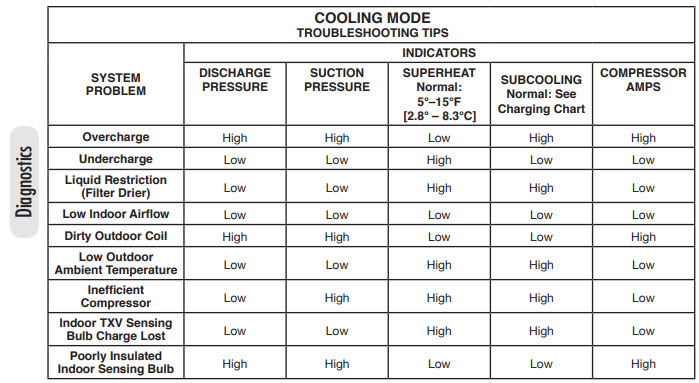High superheat with normal subcooling often indicates a low refrigerant charge or restricted airflow. These issues can lead to inefficient cooling.
Air conditioning and refrigeration systems rely on proper refrigerant levels for optimal performance. High superheat suggests the refrigerant is absorbing too much heat before returning to the compressor. This can be caused by a low refrigerant charge, which means there’s not enough refrigerant in the system.
Normal subcooling indicates that the refrigerant has been sufficiently cooled in the condenser. However, the overall system efficiency suffers. Identifying and addressing these issues promptly can prevent potential damage and ensure the system operates efficiently. Regular maintenance and monitoring can help detect and resolve these problems early.

Credit: www.reddit.com
Introduction To Superheat And Subcooling
In HVAC systems, superheat and subcooling are critical concepts. They help maintain system efficiency and performance. Understanding these terms ensures better system diagnostics and maintenance.
Importance In Hvac Systems
Superheat and subcooling play a vital role in HVAC systems. They indicate the system’s operational efficiency and health. Proper levels prevent issues like compressor damage or refrigerant overcharge.
- Superheat ensures the refrigerant vaporizes before reaching the compressor.
- Subcooling ensures the refrigerant is fully condensed before entering the evaporator.
Basic Concepts Explained
Superheat is the temperature rise above the refrigerant’s boiling point. It occurs in the evaporator and suction lines. Subcooling is the temperature drop below the refrigerant’s condensation point. It happens in the condenser and liquid lines.
| Term | Location | Function |
|---|---|---|
| Superheat | Evaporator, Suction Lines | Ensures vaporization of refrigerant |
| Subcooling | Condenser, Liquid Lines | Ensures condensation of refrigerant |
Understanding these concepts is essential for HVAC technicians. It helps in accurate system diagnosis and maintenance. Superheat and subcooling readings are crucial for system efficiency.
High Superheat: Causes And Effects
High superheat in an HVAC system can lead to many issues. Understanding the causes and effects is crucial for maintaining efficiency. This section explores the common causes and impacts on efficiency.
Common Causes
- Low Refrigerant Levels: Insufficient refrigerant can cause high superheat.
- Blocked Filters: Dirty filters can restrict airflow, leading to high superheat.
- Faulty Expansion Valve: A malfunctioning valve can result in improper refrigerant flow.
- Improper Thermostat Settings: Incorrect settings can affect the system’s performance.
Impact On Efficiency
High superheat can significantly reduce HVAC system efficiency. This can lead to higher energy bills and potential system failures.
| Issue | Effect on Efficiency |
|---|---|
| Reduced Cooling Capacity | The system works harder, consuming more energy. |
| Increased Wear and Tear | Components may wear out faster, leading to frequent repairs. |
| Potential System Overheating | This can cause the system to shut down or fail. |
Addressing high superheat issues promptly can maintain efficiency and prolong the system’s life.
Normal Subcooling: What It Means
Understanding normal subcooling in an HVAC system is important. Subcooling occurs when the refrigerant is cooled below its condensation point. This process helps the system run efficiently and reliably. Normal subcooling levels ensure the right amount of refrigerant is in the system.
Ideal Subcooling Levels
Subcooling levels are crucial for system performance. The ideal range for most systems is 10°F to 20°F. Use proper tools to measure subcooling accurately. Check the manufacturer’s specifications for exact numbers.
| System Type | Ideal Subcooling Range |
|---|---|
| Residential HVAC | 10°F – 20°F |
| Commercial HVAC | 15°F – 25°F |
Benefits For System Performance
Normal subcooling offers many benefits for your HVAC system. Here are some key advantages:
- Enhanced Efficiency: Normal subcooling helps the system run smoothly.
- Reduced Wear and Tear: Proper subcooling minimizes component stress.
- Longer Lifespan: Systems with normal subcooling last longer.
Maintaining normal subcooling is essential for your system’s health. Regular checks can keep your HVAC system running efficiently. Make sure to consult professionals if subcooling levels are off.
Balancing Superheat And Subcooling
Balancing superheat and subcooling is vital for HVAC systems. This process ensures efficient cooling and heating. Superheat and subcooling are key indicators of system health. Proper levels prevent damage and improve performance.
Achieving Optimal Levels
Optimal levels of superheat and subcooling are crucial. They ensure the system runs smoothly and efficiently.
- Superheat: Measure at the evaporator outlet. Ideal range: 10-20°F.
- Subcooling: Measure at the condenser outlet. Ideal range: 10-20°F.
Regular checks are necessary. Use reliable tools for accurate readings. Adjust settings to maintain balance.
Common Challenges
Balancing superheat and subcooling can be tricky. Common challenges include:
| Challenge | Description |
|---|---|
| High Superheat | Indicates low refrigerant or airflow issues. |
| Normal Subcooling | System might still appear normal. |
| Equipment Wear | Over time, components wear out affecting balance. |
Address these challenges promptly. Regular maintenance can prevent major issues. Always consult a professional for complex problems.
Techniques To Optimize Superheat
Optimizing superheat is crucial for efficient HVAC system performance. High superheat with normal subcooling can indicate system issues. This blog section covers techniques to optimize superheat.
Adjusting Expansion Valves
Expansion valves control the refrigerant flow. Proper adjustment ensures optimal superheat levels. Follow these steps to adjust them:
- Locate the expansion valve.
- Turn the adjustment screw. Small turns make big changes.
- Measure the superheat level. Use a reliable thermometer.
- Continue adjusting until the superheat level is ideal.
Monitoring Refrigerant Charge
Proper refrigerant charge is key to maintaining superheat. Follow this checklist to monitor it:
- Check refrigerant levels regularly.
- Use a manifold gauge set for accurate readings.
- Ensure no leaks in the system.
- Top up refrigerant if levels are low.
Keeping superheat levels in check ensures your HVAC system runs efficiently. Properly adjusted expansion valves and monitored refrigerant charge are essential techniques.
Maintaining Normal Subcooling
Maintaining normal subcooling is essential for efficient HVAC system performance. It ensures the refrigerant is properly cooled before entering the evaporator. Normal subcooling improves the system’s efficiency and longevity. Below are some tips and guidelines to help you maintain normal subcooling.
Proper Condenser Function
The condenser plays a vital role in the subcooling process. It removes heat from the refrigerant, ensuring it reaches the desired subcooling level. To maintain proper condenser function, ensure it is free of dirt and debris. Clean the condenser coils regularly.
A well-maintained condenser helps in maintaining normal subcooling. The condenser fan should also work efficiently. Make sure the fan blades are clean and not damaged.
Regular Maintenance Tips
Regular maintenance is key to keeping normal subcooling. Below are some maintenance tips:
- Check refrigerant levels: Ensure the refrigerant levels are correct. Low levels can affect subcooling.
- Inspect condenser coils: Clean and inspect the condenser coils regularly. Dirty coils reduce efficiency.
- Monitor fan performance: Ensure the fan is running smoothly. Replace any damaged fan blades.
- Check for leaks: Look for refrigerant leaks. Fix leaks immediately to maintain normal subcooling.
- Regularly schedule professional maintenance: Have a professional inspect your system at least once a year.
Following these tips helps maintain normal subcooling and ensures your HVAC system runs efficiently.
Tools For Measuring Superheat And Subcooling
Measuring superheat and subcooling is crucial for HVAC efficiency. Proper tools ensure accurate readings. This section covers the essential instruments and best practices.
Essential Instruments
Several tools are necessary to measure superheat and subcooling. Here are the most important ones:
- Digital Thermometer: Measures temperature accurately.
- Pressure Gauge: Reads system pressure.
- Superheat/Subcooling Calculator: Simplifies calculations.
- Manifold Gauge Set: Essential for refrigerant pressure measurements.
| Instrument | Function |
|---|---|
| Digital Thermometer | Measures temperature at different points. |
| Pressure Gauge | Reads the pressure in the system. |
| Superheat/Subcooling Calculator | Calculates superheat and subcooling values. |
| Manifold Gauge Set | Measures refrigerant pressures. |
Best Practices
Follow these best practices to ensure accurate measurements:
- Calibrate Instruments: Ensure all tools are calibrated.
- Check Ambient Temperature: Consider the surrounding temperature.
- Use Proper Connections: Secure all connections tightly.
- Follow Manufacturer Guidelines: Adhere to guidelines for each instrument.
Case Studies: Successful Optimizations
In this section, we will explore real-life examples of HVAC systems experiencing high superheat and normal subcooling. These case studies show how experts optimize these systems for better performance.
Real-world Examples
Let’s examine some real-world scenarios:
| Case | Issue | Solution | Result |
|---|---|---|---|
| Case 1 | High superheat due to restricted airflow | Cleaned and replaced air filters | Superheat levels returned to normal |
| Case 2 | High superheat from low refrigerant charge | Recharged refrigerant to optimal levels | Improved cooling efficiency |
| Case 3 | High superheat caused by faulty TXV | Replaced the TXV | Stable superheat and subcooling levels |
Lessons Learned
From these examples, we learn several key lessons:
- Regular maintenance is crucial for optimal HVAC performance.
- Addressing airflow issues can resolve high superheat problems.
- Proper refrigerant levels are essential for system efficiency.
- Replacing faulty components, like the TXV, can stabilize the system.
These lessons underscore the importance of proactive system checks. Regular maintenance can prevent high superheat and ensure normal subcooling.
Future Trends In Hvac Efficiency
The HVAC industry is evolving rapidly. Future trends focus on enhancing efficiency. This is crucial for systems with high superheat and normal subcooling. These trends aim to reduce energy consumption and environmental impact.
Emerging Technologies
New technologies are making HVAC systems more efficient. Smart thermostats adjust settings automatically. This reduces energy usage. IoT devices monitor system performance in real-time. Predictive maintenance prevents breakdowns. Variable refrigerant flow (VRF) systems optimize energy use. These technologies improve overall system efficiency.
Sustainability Considerations
Sustainability is a key focus in HVAC innovations. Green refrigerants reduce greenhouse gas emissions. High-efficiency compressors use less energy. Solar-powered HVAC systems harness renewable energy. Energy recovery ventilators (ERVs) reduce waste. Sustainable materials are used in new system designs. These efforts make HVAC systems more eco-friendly.
| Technology | Benefit |
|---|---|
| Smart Thermostats | Automatic adjustments to save energy |
| IoT Devices | Real-time performance monitoring |
| VRF Systems | Optimized energy use |
| Green Refrigerants | Reduced greenhouse gas emissions |
| Solar-powered Systems | Use of renewable energy |
- Smart thermostats enhance efficiency
- IoT devices monitor performance
- VRF systems optimize energy use
- Green refrigerants reduce emissions
- Solar-powered systems use renewable energy
- Adopt smart thermostats for automatic adjustments.
- Install IoT devices to monitor performance.
- Use VRF systems for optimized energy use.
- Switch to green refrigerants to cut emissions.
- Consider solar-powered systems for renewable energy.

Credit: www.reddit.com

Credit: abrwholesalers.com
Frequently Asked Questions
What Is High Superheat?
High superheat indicates that the refrigerant is absorbing more heat. This is often due to low refrigerant levels or restricted flow.
What Causes Normal Subcooling?
Normal subcooling occurs when the refrigerant is adequately condensed. Proper system charge and functioning condenser are typically the reasons for this state.
How To Fix High Superheat?
To fix high superheat, check for refrigerant leaks, ensure proper airflow, and verify the thermostatic expansion valve’s functionality.
Is High Superheat Bad?
Yes, high superheat can be harmful. It may lead to inefficient cooling and potential damage to the compressor.
Conclusion
Achieving high superheat with normal subcooling ensures optimal HVAC performance. Regular maintenance prevents system inefficiencies. Understanding these concepts helps in troubleshooting and enhancing system longevity. Implementing these practices improves energy efficiency and reduces costs. Stay informed and keep your HVAC system running smoothly for the best results.
